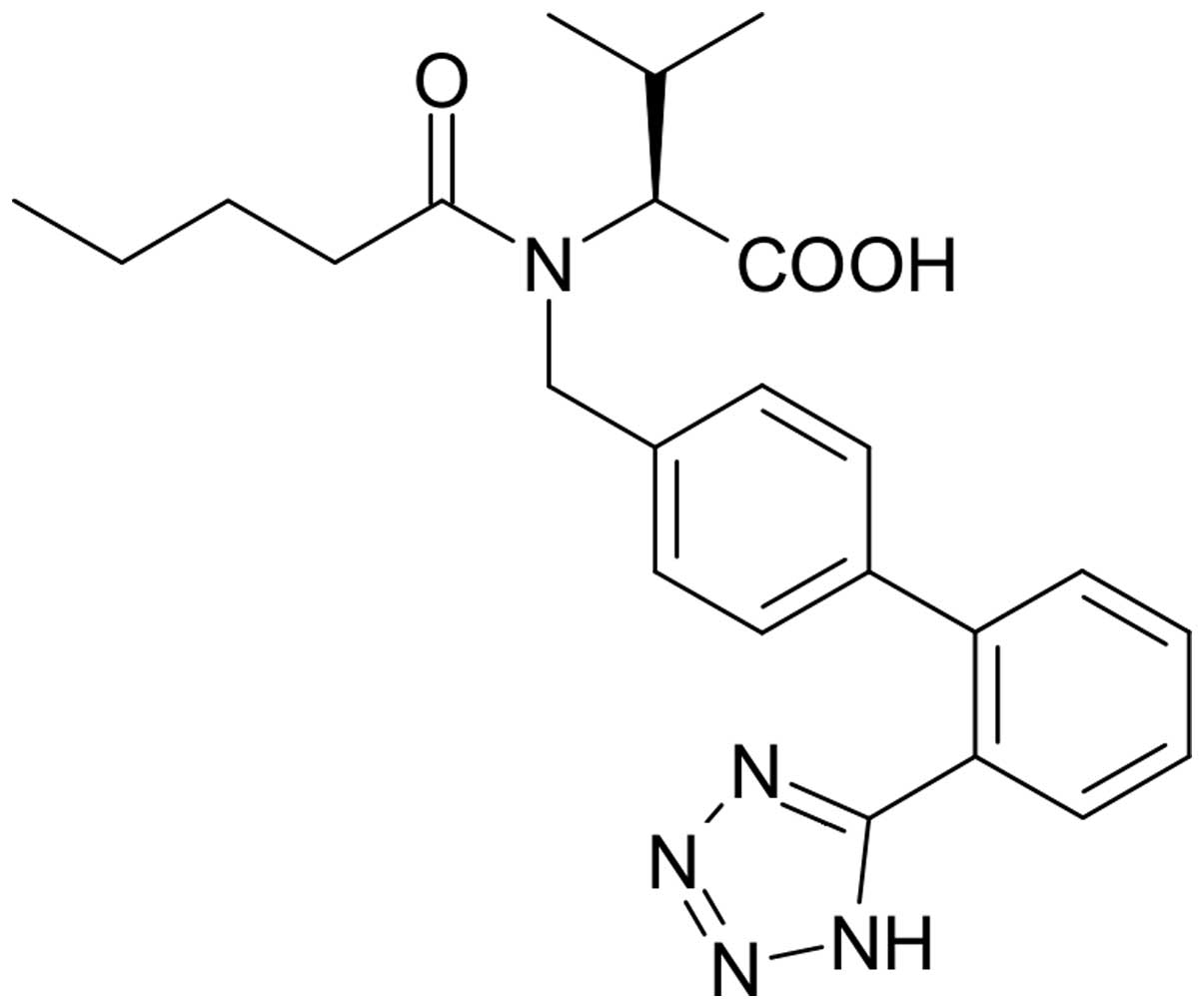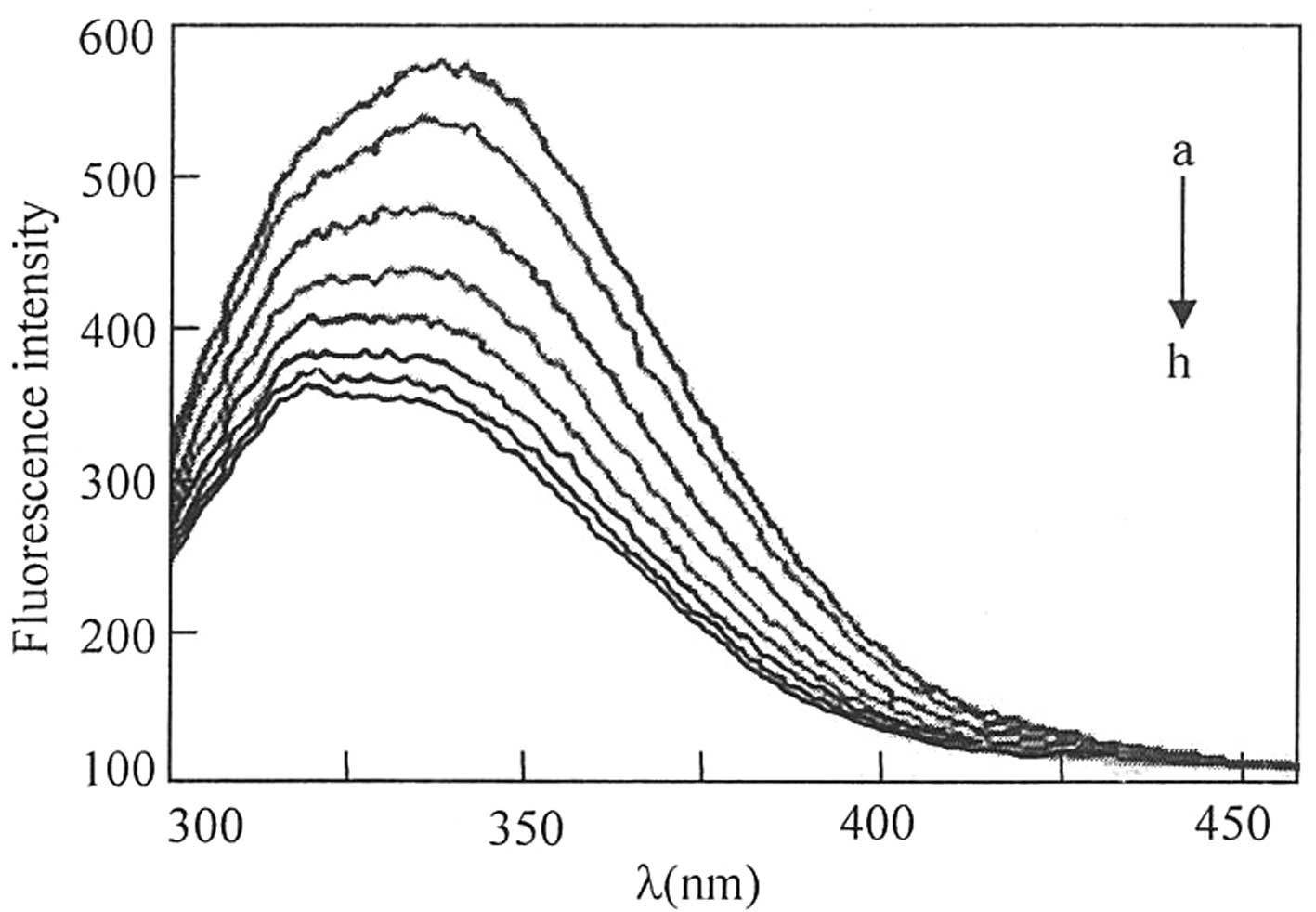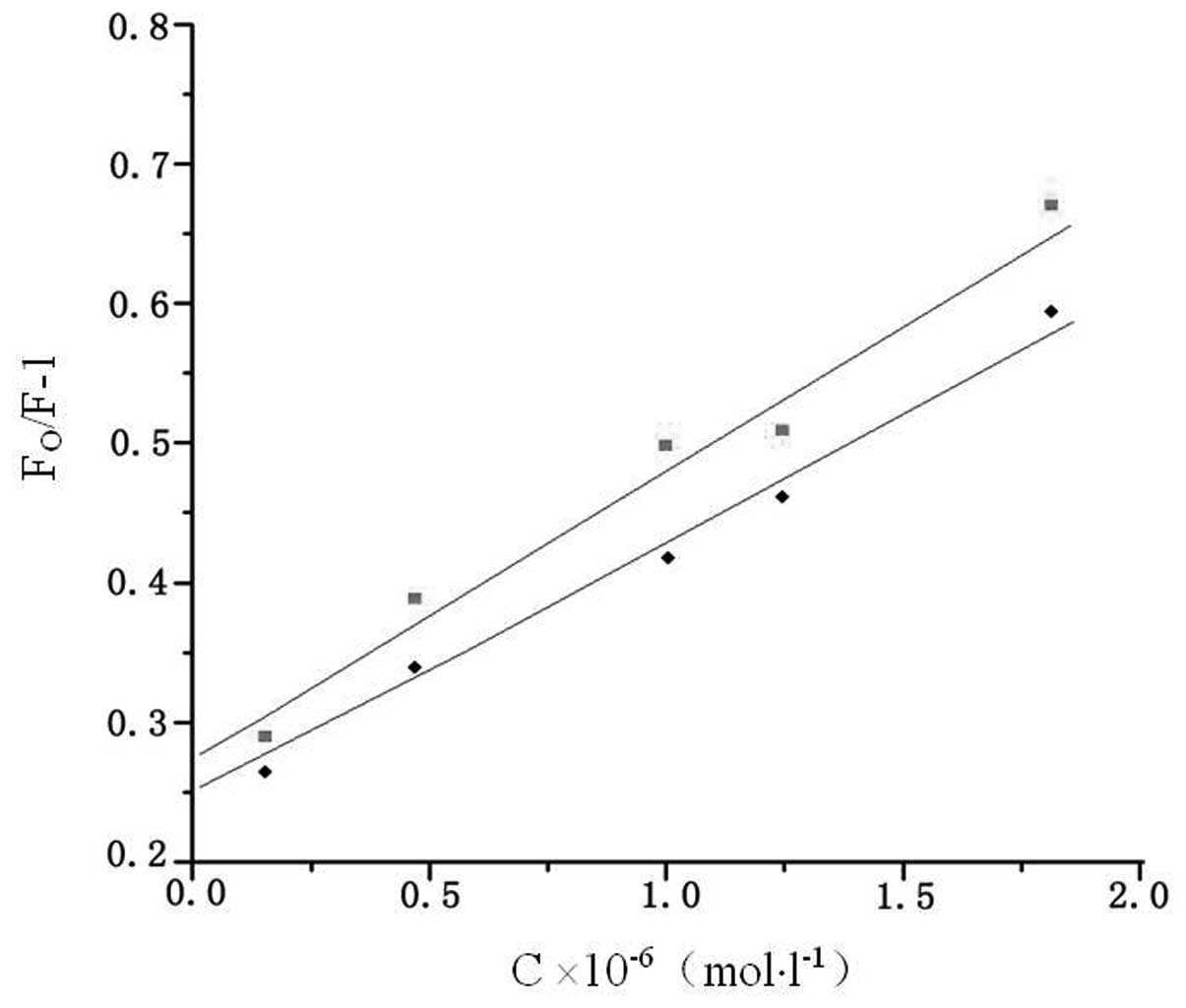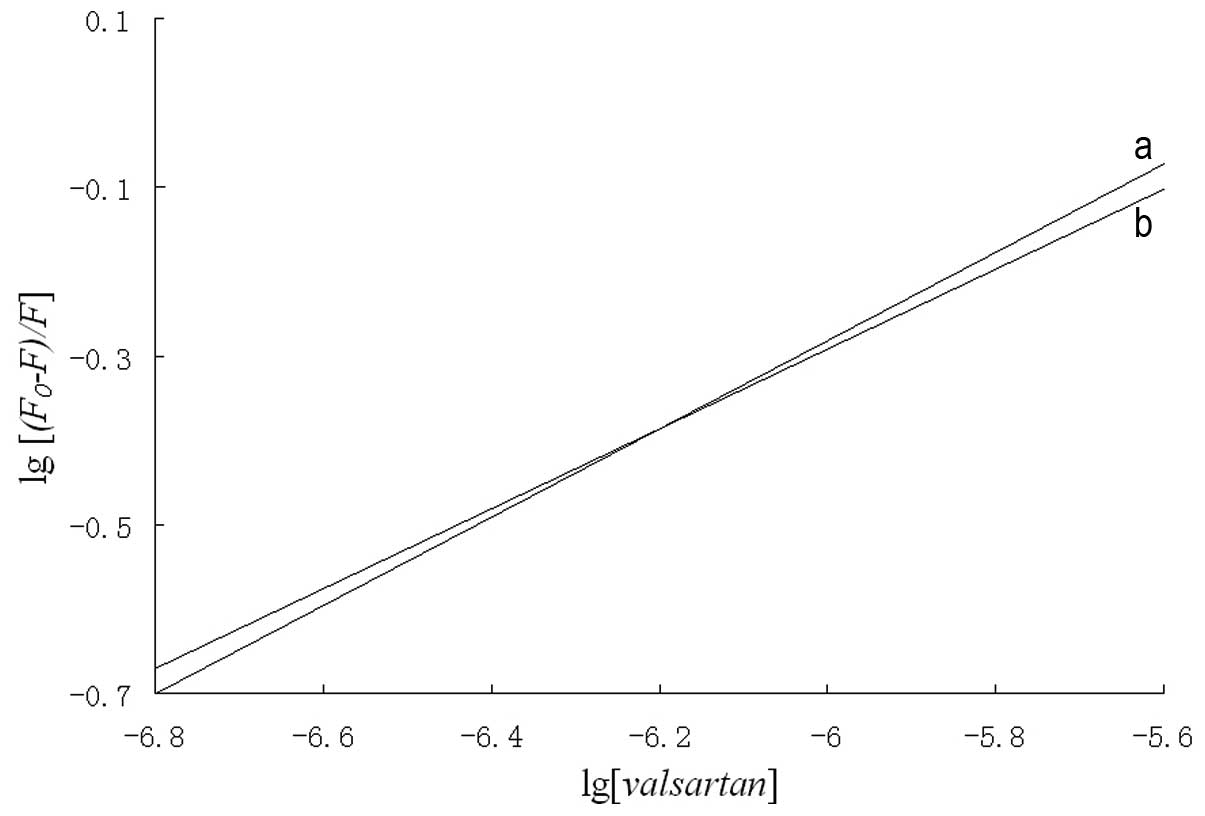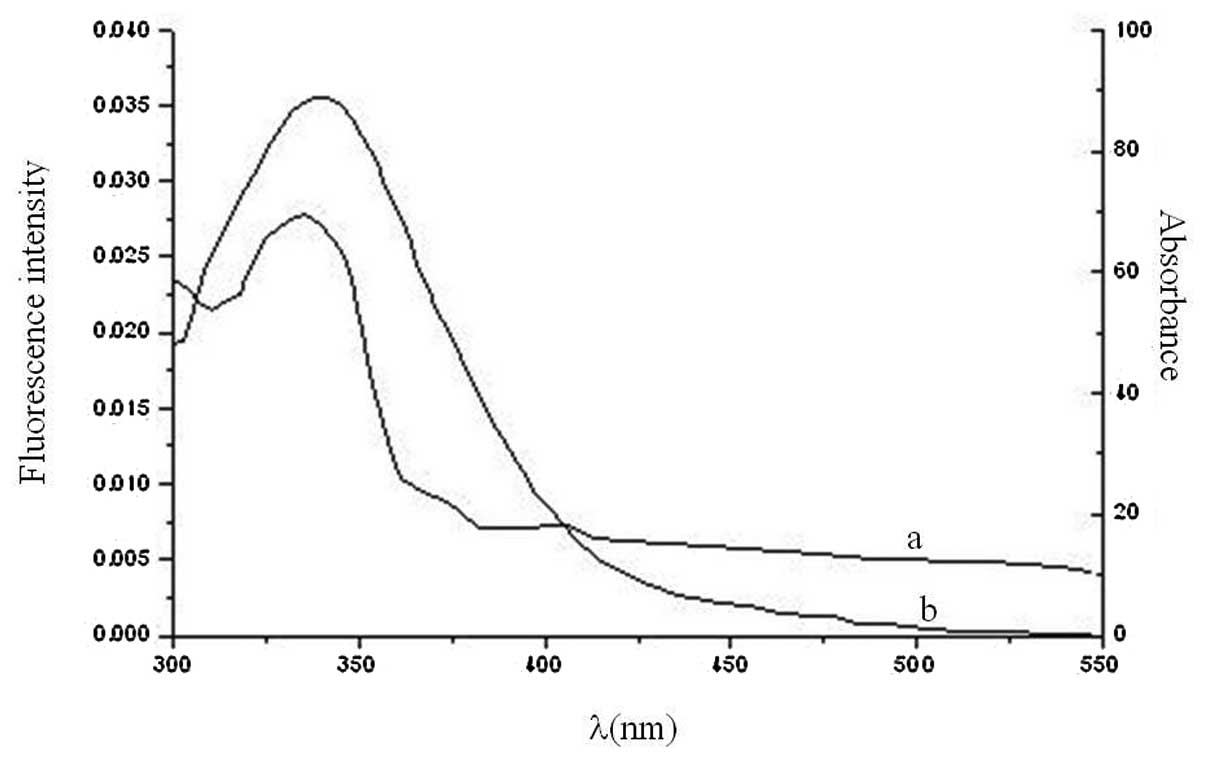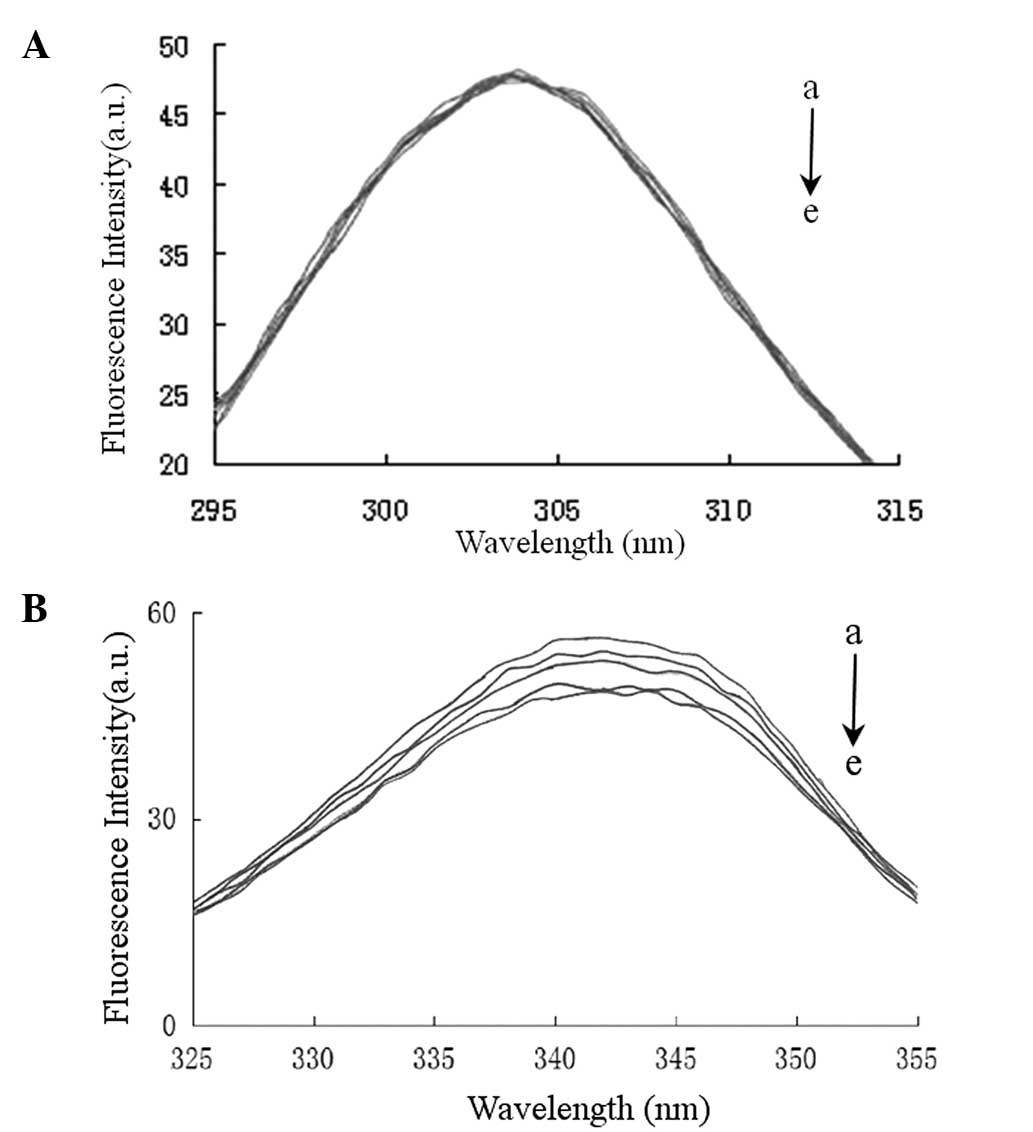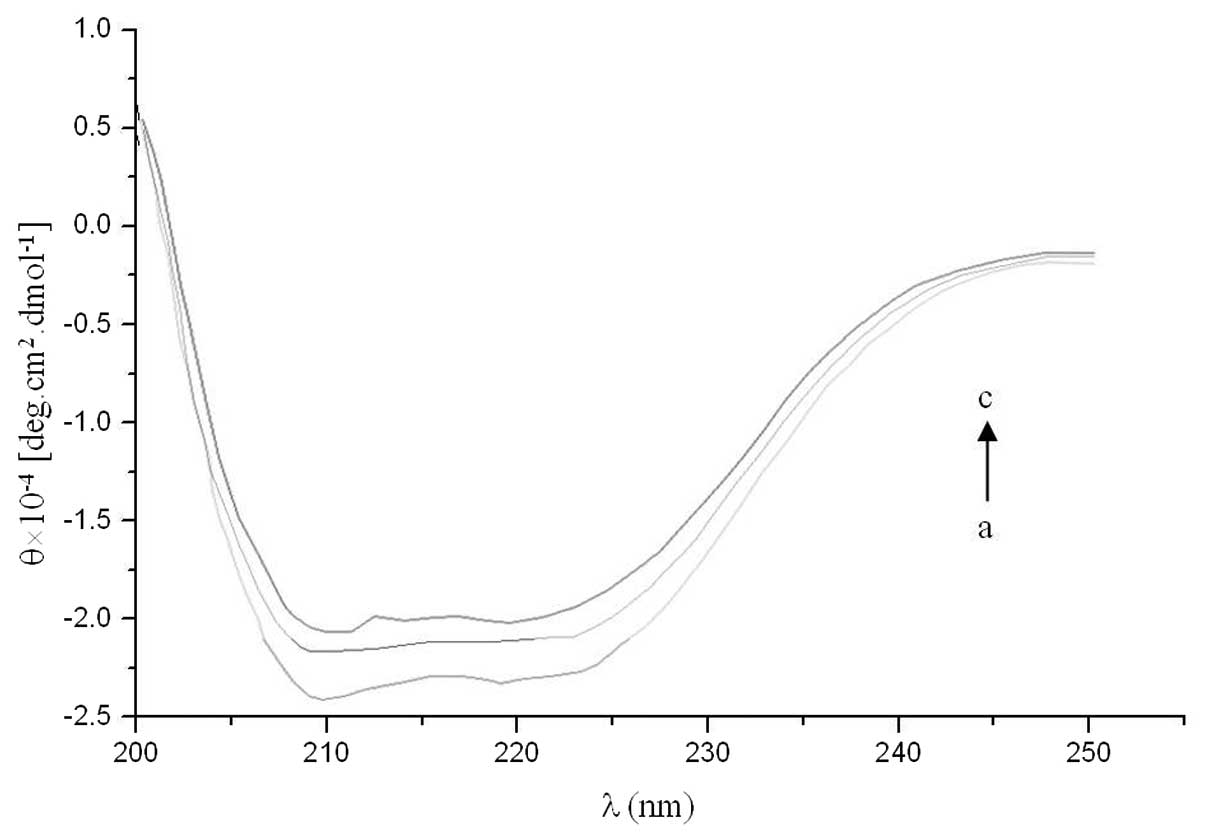Spectroscopic investigations of the interaction of the anti‑hypertension drug valsartan with human serum albumin
- Authors:
- Published online on: April 9, 2014 https://doi.org/10.3892/mmr.2014.2129
- Pages: 2191-2196
Abstract
Introduction
Serum albumins are the most prevalent soluble proteins found in vertebrates, and human serum albumin (HSA) is the predominant protein found in the plasma (1). HSA binds to a wide variety of substances, including metals, fatty acids, amino acids and hormones. The complexes formed between HSA and the ligands are involved in transport and regulatory processes (2). HSA consists of 585 amino acid residues and contains a single tryptophan (Trp) residue, Trp-214, that invariably appears in the hydrophobic cavity of subdomain IIA (3).
Valsartan, which has the chemical formula (S)-N-oxopentyl-N-{[2-(1H-5-tetrazolyl)-4-di-phenyl]methyl}-valine, is an orally potent specific non-peptide angiotensin II-receptor antagonist (Fig. 1). Valsartan has been shown to relax vascular smooth muscle, increase salt excretion, inhibit cell hypertrophy and lower blood pressure without changing the heart rate (4). As an anti-hypertension drug, the use of valsartan is effective against mild or moderate primary hypertension, particularly for kidney damage-induced secondary hypertension.
The interaction between a drug and plasma protein residues is capable of influencing the protein structure and function. Therefore, understanding the pharmacodynamics and pharmacokinetics of valsartan is of crucial importance. Investigations of this nature are likely to provide information about the structural features of valsartan that determine the therapeutic efficacy of the drug; such investigations may, therefore, become an important research field in chemistry, life sciences and clinical medicine. Several previous studies on fluorescence quenching and the mechanism of interaction between other drugs or bioactive small molecules and albumin have been reported (5–7). The knowledge gained from these studies has also been useful for the design of novel therapeutic agents (8). In the present study, the detailed mechanism underlying the interaction of valsartan with HSA was investigated using different spectroscopic techniques.
Materials and methods
Reagents and apparatus
HSA (fatty acid-free) was obtained from Sigma (St. Louis, MO, USA). The HSA solutions were prepared in 0.1 mol/l phosphate buffer (pH 7.4) containing 0.15 mol/l NaCl. HSA solutions were prepared based on the molecular weight of HSA (66,000 Da). Valsartan was obtained from Novartis (Copenhagen, Denmark). All other materials employed were of analytical grade, and Millipore water (EMD Millipore Corp., Billerica, MA, USA) was used throughout.
Fluorescence measurements were performed on a FluoroMax®-4 spectrofluorimeter (Horiba, Les Ulis, France) equipped with a 150 W xenon lamp and a slit width of 5 nm. The circular dichroism (CD) measurements were made on a Jasco-J715 spectropolarimeter (Jasco, Tokyo, Japan) using a 0.1-cm cell at 0.2-nm intervals, with three scans for each CD spectrum between 200 and 260 nm. The absorption spectra were recorded on a double-beam GBC Cintra-10e UV-Visible Spectrophotometer (Varian Medical Systems, Sydney, Australia) equipped with a 150 W xenon lamp and a slit width of 5 nm.
Analysis of valsartan-HSA interaction
On the basis of preliminary experiments, fluorescence spectra were recorded between 300 and 500 nm, and 280 and 500 nm for HSA, respectively. The concentration of HSA was maintained at 1.0×10−6 mol/l and the concentration of valsartan varied between 1.0 and 10.0×10−6 mol/l.
Ultraviolet-visible (UV-vis) absorption studies
The absorption spectra of HSA in the presence and absence of valsartan were recorded between 200 and 230 nm. The concentration of HSA was maintained at 1.0×10−6 mol/l and the concentration of valsartan varied between 1.0 and 10.0×10−6 mol/l.
Synchronous fluorescence measurements
The fluorescence studies were performed on a FluoroMax®-4 spectrofluorimeter (Horiba). The spectra were recorded between 280 and 350 nm. The synchronous fluorescence spectra were recorded with scanning ranges Δλ=15 nm and 60 nm (Δλ=λem−λex, with λem representing the wavelength of the fluorescence emission spectra, and λex referring to excitation wavelength) in the presence and absence of valsartan, to determine the spectrum characteristics of the protein residues.
Energy transfer between valsartan and HSA
The absorption spectrum of valsartan (1.0×10−6 mol/l) was recorded between 300 and 550 nm and the emission spectrum of HSA (1.0×10−6 mol/l) was recorded between 300 and 500 nm. The overlap of the UV absorption spectrum of valsartan with the fluorescence emission spectrum of protein was then used to analyze the energy transfer.
Thermodynamics of valsartan-protein interactions
The thermodynamic parameters for the binding of valsartan to HSA were determined using binding studies at two different temperatures, 303 and 310 K, in the range of 300–500 nm upon excitation at 296/280 nm using spectrofluorimetry.
Results and Discussion
Fluorescence quenching of HSA in the presence of valsartan
The interaction of valsartan with HSA (pH 7.4) was analyzed by measuring the change in the intrinsic fluorescence intensity of HSA following the addition of valsartan (Fig. 2). A total of 10 ml HSA working solution (2.0 ml buffer solution, 2.0 ml NaCl solution and 1.0 ml HSA stock solution) was prepared. A total of 2.0 ml working solution was placed in a 1-cm quartz cell and a micro-injector was used to add the valsartan solution (1.0×10−4 mol/l) gradually. No change in the fluorescence intensity was observed for the control HSA solution throughout the incubation period; however, as shown in Fig. 2, the fluorescence intensity of HSA at 340 nm decreased gradually as the concentration of valsartan increased. Fluorescence quenching refers to any process that decreases the fluorescence intensity of a sample (9) and occurs due to the interaction between HSA and valsartan. In the present study, a slight blue shift was observed for the emission wavelength as valsartan concentration increased. These results indicate that valsartan interacted with HSA and induce conformational changes in HSA. Different mechanisms of quenching are usually classified as either dynamic or static quenching, and they are distinguished by their differing dependence on temperature and viscosity (10). Dynamic quenching depends upon diffusion. Since higher temperatures result in larger diffusion coefficients, the bimolecular quenching constants are expected to increase with an increase in temperature. By contrast, increased temperature is likely to result in decreased stability of complexes, and thus lower values of quenching rate constants are observed for static quenching (11).
In order to investigate the fluorescence quenching mechanism, the fluorescence quenching data at different temperatures (303 and 310 K) were firstly analyzed using the classical Stern-Volmer equation (12) as follows: F0/F=1+Ksv[valsartan]=1+kqτ0[valsartan], where F0 and F denote the fluorescence intensities in the absence and presence of valsartan, respectively, Ksv is the Stern-Volmer quenching constant, kq is the quenching rate constant of HSA, τ0 is the average lifetime of the HSA without valsartan (the fluorescence lifetime of the biopolymer is 10−8 sec) (13), and [valsartan] is the concentration of valsartan. Fig. 3 shows the Stern-Volmer plots of F0/F versus [valsartan] at two temperatures, and the calculated Ksv and kq values are presented in Table I. The results demonstrated that the Stern-Volmer quenching constant Ksv was inversely correlated with the temperature, and that the values of kq were considerably larger than the maximum scattering collision quenching constant (2.0×1010 l/mol/sec) (14). This indicated that the probable quenching mechanism of the fluorescence of HSA by valsartan was not initiated by dynamic collision but by compound formation (15).
Binding parameters
The binding constant (K) and the number of binding sites (n) were calculated using the following equation: log(F0-F)/F=logK+nlog[valsartan]. A plot of log[(F0-F)/F] versus log[valsartan] gives a straight line where the slope is equal to n and the intercept on the y axis is equal to logK (Fig. 4). The values of K and n at 303 and 310 K are shown in Table II. The binding constant between valsartan and HSA decreased with increasing temperature, which suggests that an unstable complex exists between valsartan and HSA due to the static fluorescence quenching mechanism (16).
Table IIBinding constants and thermodynamic parameters of valsartan-human serum albumin interactions. |
UV-Vis absorption
UV-Vis absorption spectra measurement is a simple method that is used to explore structural changes and complex formation (17). The absorbance of HSA increased with the addition of valsartan, whilst the absorption wavelength remained unchanged. This suggests that the interaction between valsartan and HSA led to a ground state complex formation and a change in the microenvironment around HSA.
Determination of the force acting between valsartan and HSA
Owing to the dependence of the binding constant on temperature, the thermodynamic parameters dependent on temperature were analyzed in order to further characterize the acting force in the valsartan-HSA complex (18). The acting forces between small molecules and macromolecules primarily include hydrogen bonds, van der Waals forces, and electrostatic and hydrophobic interaction forces. The thermodynamic parameters of enthalpy change (ΔH), entropy change (ΔS) and free energy change (ΔG) are the main factors used to determine the binding mode (19). When the change in temperature is not clear, ΔH is considered a constant. ΔH and ΔS values were calculated from the van’t Hoff equation and obtained from a linear van’t Hoff plot, as follows: lnK=−ΔH/RT+ΔS/R. K is analogous to the effective quenching constant Ksv and R is the gas constant. The free energy change (ΔG) was estimated from the following equation: ΔG= ΔH-TΔS. The results are shown in Table II. The positive ΔS arose due to the more random arrangement of water molecules around HSA and valsartan, which was caused by hydrophobic interactions between valsartan and HSA. Negative ΔG values revealed the spontaneity of the binding process. The negative H value (−24.9 kJ/mol) was regarded as very small, almost zero, and so the interaction was not attributed to electrostatic forces (19). Therefore, from the thermodynamic characteristics summarized above, the negative ΔH and positive ΔS values indicate that hydrogen bonds and hydrophobic interaction have a major role in the valsartan-HSA binding reaction and contribute to the interaction and stability of the complex. The structures of serum albumins are particularly complex, so the interaction forces between valsartan and serum albumins may not be forces that are frequently observed; however, they may be more common under certain conditions.
Fluorescence resonance energy transfer (FRET)
FRET is a nondestructive spectroscopic method that analyzes the proximity and relative angular orientation of fluorophores (20). According to the theory proposed by Förster (21), the efficiency of FRET depends mainly on the following factors: (i) The extent of overlap between the donor emission and the acceptor absorption spectrum; (ii) the orientation of the transition dipole of donor and acceptor and (iii) the distance between the donor and the acceptor. In the present study the donor and acceptor were HSA and valsartan, respectively. The overlap between the absorption spectrum of valsartan and the fluorescence emission spectrum of HSA is shown in Fig. 5.
The efficiency of energy transfer between the donor and acceptor, E, was calculated using the following equation: E=1−F/F0=R06/(R06+r6), where r is the binding distance between donor and acceptor and R0 is the critical distance at 50% transfer efficiency. In addition, R06 may be calculated as follows: R06=8.8×10−25K2N−4ϕJ, where K2 is the orientation factor between the emission dipole of the donor and the absorption dipole of the acceptor, N is the average refractive index of the medium in the wavelength range where the spectral overlap is significant, ϕ is the fluorescence quantum yield of the donor and J is the overlap integral of the fluorescence emission spectrum of the donor and the absorption spectrum of the acceptor. Therefore, J=∑F(λ)ɛ(λ)λ4Δλ/∑F(λ)Δλ, where F(λ) is the fluorescence intensity of the donor in the wavelength range λ to λ+Δλ, and ɛ(λ) is the extinction coefficient of the acceptor at λ. In present study, K2=2/3, N=1.336 and ϕ=0.12 for HAS (22). From the equations, the values found were J=2.02×10−14 cm3/l/mol, R0=1.792 nm, E=0.3410 and r=1.994 nm. The donor-to-acceptor distance, r, was<7 nm (23) and 0.5R0<r<1.5R0 (24), which is in accordance with Förster’s theory and suggests, with high probability, that nonradiative energy transfer from HSA to valsartan occurred (25). These results also indicate that valsartan strongly quenched the intrinsic fluorescence of HSA by the static quenching mechanism (26)
Conformational investigations by the synchronous fluorescence method
The synchronous fluorescence of HSA was investigated to evaluate the change in the microenvironments of tyrosine (Tyr) and Trp residues as a result of valsartan binding. The excitation and emission monochromators were synchronously scanned, separated by a constant wavelength interval Δλ(Δλ=λem−λex). When Δλ=15 nm, the spectrum characteristic of the protein Tyr residues was observed, and when Δλ=60 nm the spectrum characteristic of protein Trp residues was observed (27). The fluorescence emission peaks for aromatic Tyr and Trp residues are sensitive to the polarity of their environment. Fig. 6 demonstrates the effect of the addition of valsartan on the synchronous fluorescence spectra of HSA when Δλ=15 or 60 nm. Fig. 6 shows that the maximum emission wavelength of Tyr and Trp residues did not change significantly; however, the fluorescence intensity of Trp decreased, whereas that of Tyr remained almost unchanged. The results suggested that the binding between valsartan and the protein did not lead to a change in the polarity of the microenvironment of the Trp and Tyr residues; however, the internal packing of the protein changed (28). Furthermore, the results suggested that valsartan predominantly binds to Trp residues, but this binding does not appear to induce large structural changes in the microenvironment around the Trp residues.
CD spectroscopy studies
The albumin structure is predominantly α-helical. Approximately 60.78% of HSA is helical and the number of helices in the structure is 28 (29). CD spectra were used to analyze the interaction between valsartan and albumin. The results from the stepwise CD titration of albumin with increasing amounts of valsartan are shown in Fig. 7. The CD spectra of HSA exhibited two negative bands in the UV region at 209 and 222 nm, characteristic of an α-helical protein structure. The binding of valsartan to HSA distinctly decreased these bands. This indicated that considerable changes in the protein secondary structure had occurred, i.e. the decrease in the α-helical content of the protein, which may have been the result of the formation of a complex between the protein and valsartan.
In conclusion, HSA is the main constituent of plasma proteins and is responsible for the binding and transport of numerous molecules, including valsartan. Drug binding to HSA is a major problem in pharmaceutical research since the binding to albumin influences the effective valsartan concentration that can obtained at the target site. In the present study the interaction of valsartan with HSA was investigated in vitro using fluorescence emission, UV-Vis, CD and synchronous fluorescence spectroscopy. The results from the fluorescence experiments revealed that the intrinsic fluorescence of HSA was quenched by a static quenching process. The changes in enthalpy (ΔH) and entropy (ΔS) for the reaction were found to be −24.9 kJ/mol and 36.3 J/mol/K, suggesting that hydrophobic interactions and hydrogen bonds were the dominant inter-molecular forces stabilizing the complex. The distance between valsartan and HSA was sufficiently close (r=1.994 nm) to induce nonradiative energy transfer from HSA to valsartan. The results of the synchronous fluorescence and CD spectra suggest that the protein secondary structure was altered and the physiological state of HSA was affected by valsartan. This binding study of valsartan with HSA is of biological importance and has particular significance for pharmacology and clinical medicine, as well as methodology.
Acknowledgements
This study was supported by the Fundamental Research Program of China Universities, Beijing Normal University (SD2010.1.1). The authors would like to thank Professor J.X. Si, of the Academy of Medical Sciences, for her assistance during the CD measurement experiments.
References
|
Xiao J, Shi J, Cao H, Wu S, Ren F and Xu M: Analysis of binding interaction between puerarin and bovine serum albumin by multi-spectroscopic method. J Pharm Biomed Anal. 45:609–615. 2007. View Article : Google Scholar : PubMed/NCBI | |
|
He W, Li Y, Xue C, Hu Z, Chen X and Sheng F: Effect of Chinese medicine alpinetin on the structure of human serum albumin. Bioorg Med Chem. 13:1837–1845. 2005. View Article : Google Scholar : PubMed/NCBI | |
|
Sułkowska A, Maciazek M, Równicka J, Bojko B, Pentak D and Sułkowski WW: Effect of temperature on the methotrexate-BSA interaction: Spectroscopic study. J Mol Struct. 834–836:162–169. 2007. | |
|
Barakat K, Clark R and Davis M: Valsartan: Hypertension and Cardiovascular Disease. CSF Medical Communications Ltd; Witney: 2004 | |
|
Mote US, Bhattar SL, Patil SR and Kolekar GB: Interaction between felodipine and bovine serum albumin: fluorescence quenching study. Luminescence. 25:1–8. 2010.PubMed/NCBI | |
|
Varlan A and Hillebrand M: Bovine and human serum balbumin interactions with 3-carboxyphenoxathiin studied by fluorescence and circular dichroism spectroscopy. Molecules. 15:3905–3919. 2010. View Article : Google Scholar : PubMed/NCBI | |
|
Neelam S, Gokara M, Sudhamalla B, Amooru DG and Subramanym RJ: Interaction studies of coumaroyltyramine with human serum albumin and its biological importance. J Phys Chem B. 114:3005–3012. 2010. View Article : Google Scholar : PubMed/NCBI | |
|
He WY, Chen HJ, Sheng FL and Yao XJ: Molecular modeling and spectroscopic studies on binding of 2,6-bis[4-(4-amino-2trifluoromethylphenoxy)benzoyl] pyridine to human serum albumin. Spectrochim Acta A Mol Biomol Spectrosc. 74:427–433. 2009.PubMed/NCBI | |
|
Silva D, Cortez CM, Cunha-Bastos J and Louro SR: Methyl parathion interaction with human and bovine serum albumin. Toxicol Lett. 147:53–61. 2004. View Article : Google Scholar : PubMed/NCBI | |
|
Yue Y, Chen X, Qin J and Yao X: Spectroscopic investigation on the binding of antineoplastic drug oxaliplatin to human serum albumin and molecular modeling. Colloids Surf Biointerfaces. 69:51–57. 2009. View Article : Google Scholar : PubMed/NCBI | |
|
Lemma T and Pawliszyn J: Human serum albumin interaction with oxaliplatin studied by capillary isoelectric focusing with the whole column imaging detection and spectroscopic method. J Pharm Biomed Anal. 50:570–575. 2009. View Article : Google Scholar | |
|
Lakowicz JR: Principles of Fluorescence Spectroscopy. 2nd edition. Kluwer Academic/Plenum; New York, NY: 1999, View Article : Google Scholar | |
|
Lakowicz JR and Weber G: Quenching of fluorescence by oxygen. A probe for structural fluctuations in macromolecules. Biochemistry. 12:4161–4170. 1973. View Article : Google Scholar : PubMed/NCBI | |
|
Ware WR: Oxygen quenching of fluorescence in solution: An experimental study of the diffusion process. J Phys Chem. 66:455–458. 1962. View Article : Google Scholar | |
|
He Y, Wang Y, Tang L, Liu H, Chen W, Zheng Z and Zou G: Binding of puerarin to human serum albumin: a spectroscopic analysis and molecular docking. J Fluoresc. 18:433–442. 2008. View Article : Google Scholar : PubMed/NCBI | |
|
Sarkar D, Mahata A, Das P, Girigoswami A, Ghosh D and Chattopadhyay N: Deciphering the perturbation of serum albumins by a ketocyanine dye: a spectroscopic approach. J Photochem Photobiol B. 96:136–143. 2009. View Article : Google Scholar : PubMed/NCBI | |
|
Wang YQ, Tang BP, Zhang HM, Zhou QH and Zhang GC: Studies on the interaction between imidacloprid and human serum albumin: spectroscopic approach. J Photochem Photobiol B. 94:183–190. 2009. View Article : Google Scholar : PubMed/NCBI | |
|
Daneshgar P, Moosavi-Movahedi AA, Norouzi P, Ganjali MR, Madadkar-Sobhani A and Saboury AA: Molecular interaction of human serum albumin with paracetamol: spectroscopic and molecular modeling studies. Int J Biol Macromol. 45:129–134. 2009. View Article : Google Scholar : PubMed/NCBI | |
|
Ross PD and Subramanian S: Thermodynamics of protein association reactions: forces contributing to stability. Biochemistry. 20:3096–3102. 1981. View Article : Google Scholar : PubMed/NCBI | |
|
Stryer L and Haugland RP: Energy transfer: a spectroscopic ruler. Proc Natl Acad Sci USA. 58:719–726. 1967. View Article : Google Scholar : PubMed/NCBI | |
|
Förster T: Intermolecular energy migration and fluorescence. Ann Phys. 437:55–75. 1948.(In German). | |
|
Cyril L, Earl JK and Sperry WM: Biochemists handbook. E & FN Epon Led Press; London: 1961 | |
|
Valeur B and Brochon JC: New Trends in Influorescence Spectroscopy. 6th edition. Springer Press; Berlin: 1999 | |
|
Valeur B: Molecular Fluorescence: Principles and Applications. Wiley Press; New York, NY: 2001, View Article : Google Scholar | |
|
Sun Y and Zhang H, Sun Y, Zhang Y, Liu H, Cheng J, Bi S and Zhang H: Study of interaction between protein and main active components in Citrus aurantium L. by optical spectroscopy. J Lumin. 130:270–279. 2010. View Article : Google Scholar | |
|
Abou-Zied OK and Alshihi OI: Characterization of subdomain IIA binding site of humanserum albumin in its native, unfolded, and refolded states using small molecular probes. J Am Chem Soc. 130:10793–10801. 2008. View Article : Google Scholar : PubMed/NCBI | |
|
Mandal P and Ganguly T: Fluorescence spectroscopic characterization of the interaction of human adult hemoglobin and two isatins, 1-methylisatin and 1-phenylisatin: a comparative study. J Phys Chem B. 113:14904–14913. 2009. View Article : Google Scholar | |
|
Grigoryan KR, Aznauryan MG, Bagramyan NA, Gevorkyan LG and Markaryan SA: Spectroscopic determination of binding between human serum albumin and a platinum(II) demethylsulfoxide complex. J Appl Spectrosc. 75:593–596. 2008. View Article : Google Scholar | |
|
Carter DC and Ho JX: Structure of serum albumin. Adv Protein Chem. 45:153–203. 1994. View Article : Google Scholar : PubMed/NCBI |



